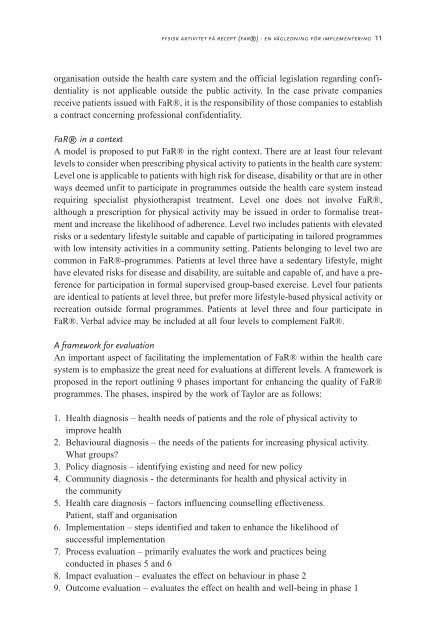Fysisk aktivitet på recept (FaR) - en vägledning för implementering
Fysisk aktivitet på recept (FaR) - en vägledning för implementering
Fysisk aktivitet på recept (FaR) - en vägledning för implementering
You also want an ePaper? Increase the reach of your titles
YUMPU automatically turns print PDFs into web optimized ePapers that Google loves.
fysisk <strong>aktivitet</strong> <strong>på</strong> <strong>recept</strong> (far®) - <strong>en</strong> <strong>vägledning</strong> <strong>för</strong> implem<strong>en</strong>tering 11<br />
organisation outside the health care system and the official legislation regarding confid<strong>en</strong>tiality<br />
is not applicable outside the public activity. In the case private companies<br />
receive pati<strong>en</strong>ts issued with <strong>FaR</strong>®, it is the responsibility of those companies to establish<br />
a contract concerning professional confid<strong>en</strong>tiality.<br />
<strong>FaR</strong>® in a context<br />
A model is proposed to put <strong>FaR</strong>® in the right context. There are at least four relevant<br />
levels to consider wh<strong>en</strong> prescribing physical activity to pati<strong>en</strong>ts in the health care system:<br />
Level one is applicable to pati<strong>en</strong>ts with high risk for disease, disability or that are in other<br />
ways deemed unfit to participate in programmes outside the health care system instead<br />
requiring specialist physiotherapist treatm<strong>en</strong>t. Level one does not involve <strong>FaR</strong>®,<br />
although a prescription for physical activity may be issued in order to formalise treatm<strong>en</strong>t<br />
and increase the likelihood of adher<strong>en</strong>ce. Level two includes pati<strong>en</strong>ts with elevated<br />
risks or a sed<strong>en</strong>tary lifestyle suitable and capable of participating in tailored programmes<br />
with low int<strong>en</strong>sity activities in a community setting. Pati<strong>en</strong>ts belonging to level two are<br />
common in <strong>FaR</strong>®-programmes. Pati<strong>en</strong>ts at level three have a sed<strong>en</strong>tary lifestyle, might<br />
have elevated risks for disease and disability, are suitable and capable of, and have a prefer<strong>en</strong>ce<br />
for participation in formal supervised group-based exercise. Level four pati<strong>en</strong>ts<br />
are id<strong>en</strong>tical to pati<strong>en</strong>ts at level three, but prefer more lifestyle-based physical activity or<br />
recreation outside formal programmes. Pati<strong>en</strong>ts at level three and four participate in<br />
<strong>FaR</strong>®. Verbal advice may be included at all four levels to complem<strong>en</strong>t <strong>FaR</strong>®.<br />
A framework for evaluation<br />
An important aspect of facilitating the implem<strong>en</strong>tation of <strong>FaR</strong>® within the health care<br />
system is to emphasize the great need for evaluations at differ<strong>en</strong>t levels. A framework is<br />
proposed in the report outlining 9 phases important for <strong>en</strong>hancing the quality of <strong>FaR</strong>®<br />
programmes. The phases, inspired by the work of Taylor are as follows:<br />
1. Health diagnosis – health needs of pati<strong>en</strong>ts and the role of physical activity to<br />
improve health<br />
2. Behavioural diagnosis – the needs of the pati<strong>en</strong>ts for increasing physical activity.<br />
What groups?<br />
3. Policy diagnosis – id<strong>en</strong>tifying existing and need for new policy<br />
4. Community diagnosis - the determinants for health and physical activity in<br />
the community<br />
5. Health care diagnosis – factors influ<strong>en</strong>cing counselling effectiv<strong>en</strong>ess.<br />
Pati<strong>en</strong>t, staff and organisation<br />
6. Implem<strong>en</strong>tation – steps id<strong>en</strong>tified and tak<strong>en</strong> to <strong>en</strong>hance the likelihood of<br />
successful implem<strong>en</strong>tation<br />
7. Process evaluation – primarily evaluates the work and practices being<br />
conducted in phases 5 and 6<br />
8. Impact evaluation – evaluates the effect on behaviour in phase 2<br />
9. Outcome evaluation – evaluates the effect on health and well-being in phase 1

















